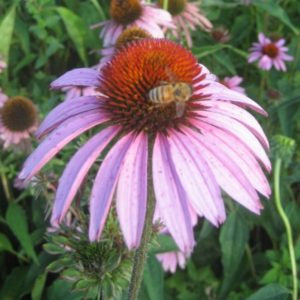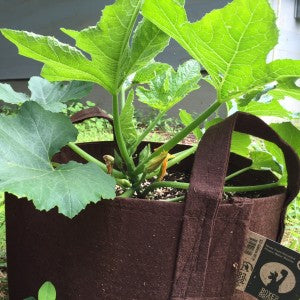We know what you're thinking: It's not winter yet! There's a whole season between then and now! But don't be alarmed; we're not dismissing fall and all the beautiful things that season has in store. All the same, there are lots of things you can do starting now to ensure that you have a wonderful winter too. Loving the veggies you're pulling out of your garden? Stopping to gaze at flowers buzzing with bees? Make sure you keep that experience going as long into the winter and as early in the spring as possible by overwintering plants and seeds. Here's how to do it.
 Vegetables: Cool-weather-loving crops like broccoli, Brussels sprouts, cabbage, and cauliflower don’t mind a few frosts. Their flavor will be enhanced by the frost (the plant will concentrate its sugars in the leaves and fruit to act as antifreeze) and they will use warm days to grow, albeit slowly. Use a row cover to add a few degrees of warmth and to extend the season even further. These crops won’t, however, make it all the way through winter. Harvest for as long as possible, then remove and send to the compost pile.
Vegetables: Cool-weather-loving crops like broccoli, Brussels sprouts, cabbage, and cauliflower don’t mind a few frosts. Their flavor will be enhanced by the frost (the plant will concentrate its sugars in the leaves and fruit to act as antifreeze) and they will use warm days to grow, albeit slowly. Use a row cover to add a few degrees of warmth and to extend the season even further. These crops won’t, however, make it all the way through winter. Harvest for as long as possible, then remove and send to the compost pile.
Parsnips, carrots, garlic, scallions, and hardy greens (such as kale, lettuces, spinach, Asian greens, and mache) are winter survivors. They not only taste sweeter after a few frosts, but can be harvested on an as-needed basis through the winter and some into next spring. Protect them with six to eight inches of mulch to prevent the soil from heaving. Hardy greens benefit from row cover with hoops, a plastic cover, or a cold frame, which will keep them warm and growing (slowly) and will keep snow off for easy harvesting.
And don't forget: just as important as the planting is the harvesting! If you're wondering how to make the most of your fall and winter bounty, check out our series on harvesting and storing vegetables for winter.
Perennial vegetables and herbs: Asparagus, rhubarb, and other perennial vegetables as well as perennial herbs such as chives, sage, thyme, oregano, tarragon, arnica, and anise hyssop store energy in their roots over the winter and grow anew from the base each spring. So, after foliage dies back in late fall, cut these plants down to a couple of inches from the ground. Now is also a great time to top-dress perennial beds with compost, manure, and mulch – the nutrients will seep into the soil over the winter and be accessible for the plants in spring.
 Flowers: Now is also an ideal period for sowing flower varieties whose seeds require stratification, or a cold period, before germinating. Poppies, Milkweed, Johnny Jump-ups, and Echinacea are all flowers that need a winter-like environment before germinating. See our full list of fall-sown flowers here.
Flowers: Now is also an ideal period for sowing flower varieties whose seeds require stratification, or a cold period, before germinating. Poppies, Milkweed, Johnny Jump-ups, and Echinacea are all flowers that need a winter-like environment before germinating. See our full list of fall-sown flowers here.
Biennial seed crops: Some plants take two seasons to produce seed. In our region, the majority of biennial seed crops need to be taken out of the ground and stored over the winter to keep them warm enough for the next growing season, but hardier varieties like parsnips and leeks can overwinter right in the ground. Tucking them in for winter with mulch or straw and putting a row cover over them will help them survive the coldest periods. And, snow will actually help insulate them. For more information on growing and storing biennials for seed production, take a look here.
 Potted plants: Most container plants will need to be brought inside in order to make it through the winter because containers keep the roots more exposed to cold than plants in the ground. However, there are a few tricks for keeping potted plants bundled up and warm enough outdoors. For a thorough overview on overwintering plants in containers (and great suggestions for ornamentals), we recommend reading Margaret Roach’s, A Way to Garden blog, a wonderful gardening resource.
Potted plants: Most container plants will need to be brought inside in order to make it through the winter because containers keep the roots more exposed to cold than plants in the ground. However, there are a few tricks for keeping potted plants bundled up and warm enough outdoors. For a thorough overview on overwintering plants in containers (and great suggestions for ornamentals), we recommend reading Margaret Roach’s, A Way to Garden blog, a wonderful gardening resource.
You can also check out our recycled fabric planters. We've got a size and a color for every plant you can make space for. And they've got handles, too, which makes them easy to move in and out of your house.
Cover crops: Maybe you need a break from gardening this winter, or maybe your soil does. Cover crops are the best way to keep your soil safe--and even make it healthier--while not tending other crops. They protect from erosion, fix nutrients, and add organic matter. To read more about their benefits and how to grow them, read our article on cover crops for home gardeners.
Wondering what goes in the ground right now? Check out this article to get started.





